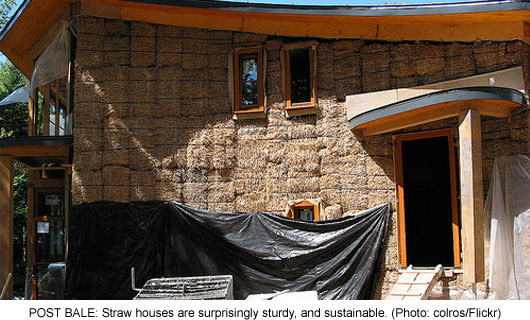|
On
an Indian reservation in Montana, students and volunteers build
homes out of straw.
 Each
year, David Riley, an associate professor in Penn State's Architectural
Engineering Department, takes a group of students, alumni, and other
interested parties to Montana. There, Riley leads the group in building
homes and other community buildings for the Northern Cheyenne Indian
tribe. Each
year, David Riley, an associate professor in Penn State's Architectural
Engineering Department, takes a group of students, alumni, and other
interested parties to Montana. There, Riley leads the group in building
homes and other community buildings for the Northern Cheyenne Indian
tribe.
While it may sound similar to Habitat for Humanity, there’s
something decidedly unique about the structures Riley’s crew
builds: They’re made out of straw. Despite the experience of
the first little pig whose house was blown down, these buildings
are sturdy. And an added eco-bonus is that straw is a sustainable
building material.
“People need houses,” Riley says, “and they need
to be durable and affordable.”
Riley started the American Indian Housing Initiative (AIHI) in 1998.
He used straw from the beginning for economic and TK reasons. These
days, straw remains the base building material, but Riley is aiming
to make the houses even more sustainable. AIHI’s newest project
will add renewable energy in the mix as the group continues to help
address the housing crisis many Native Americans face.
More than 40 percent of the homes on reservations are overcrowded
or in serious disrepair, and the Native American Indian Housing
Council estimates there is an immediate need for over 200,000 housing
units. Adding to the problem is the high number of Native Americans
living in poverty.
Straw, which is used to make strawbale houses, is “an abundant
and low-cost material with over 140 million tons produced in North
America annually,” says Jude Simpson, an employee at Penn State
University’s Center for Sustainability, who has accompanied
Riley to Montana. “Since it is a secondary agricultural waste
product from grain production, its embodied energy is low.”
Other factors that make straw desirable are the material’s
high insulation properties, its availability in Montana, and the
organic feel of a strawbale home on the landscape. In addition,
says Riley, the simplicity of the process allows people with little
building experience to play a vital role in the construction process.
“It’s a housing concept that combines a holistic solution,”
says Riley. “It’s appropriate for the region.”
AIHI’s initial aim was to build only houses. But Riley recognized
that it was important to focus on the good of the entire Northern
Cheyenne reservation, so he started with the first of five community-based
projects, which include an Early Childhood Learning Center. The
building was the most ambitious project to date, consisting of a
strawbale shell and an energy-efficient design that allows maximum
daylight lighting, floor radiant heating, and evaporative cooling.
The learning center adheres to the guidelines of a LEED Gold certification.
Currently, AIHI is focusing more sharply on sustainability and renewable
resources. Riley is now constructing two prototype homes in conjunction
with Penn State’s Solar Decathlon Team. One of the homes will
be used as a renewable energy laboratory. The other will be a demonstration
solar home on the campus of Montana’s Chief Dull Knife College,
which Riley sees as the future of his strawbale construction.
Riley also sees his work constructing homes and public buildings
as just the first step in helping the Northern Cheyenne tribe develop
a viable and sustainable community. Already the tribe has constructed
a factory on the reservation to manufacture sections of the building,
particularly the part of the home that houses the HVAC and similar
units. Most of the house is built from local products. “It’s
a house that also creates jobs,” Riley says. “And the
money used to build and buy the homes stays as close to the community
as possible.”
“This type of building process adds value of engaging members
of the tribe with the building process to help dispel apprehension
about this relatively new and different building technique,”
says Simpson. “I believe the Northern Cheyenne will embrace
these housing solutions as a viable option to the present government
housing programs.”
|




 Each
year, David Riley, an associate professor in Penn State's Architectural
Engineering Department, takes a group of students, alumni, and other
interested parties to Montana. There, Riley leads the group in building
homes and other community buildings for the Northern Cheyenne Indian
tribe.
Each
year, David Riley, an associate professor in Penn State's Architectural
Engineering Department, takes a group of students, alumni, and other
interested parties to Montana. There, Riley leads the group in building
homes and other community buildings for the Northern Cheyenne Indian
tribe.